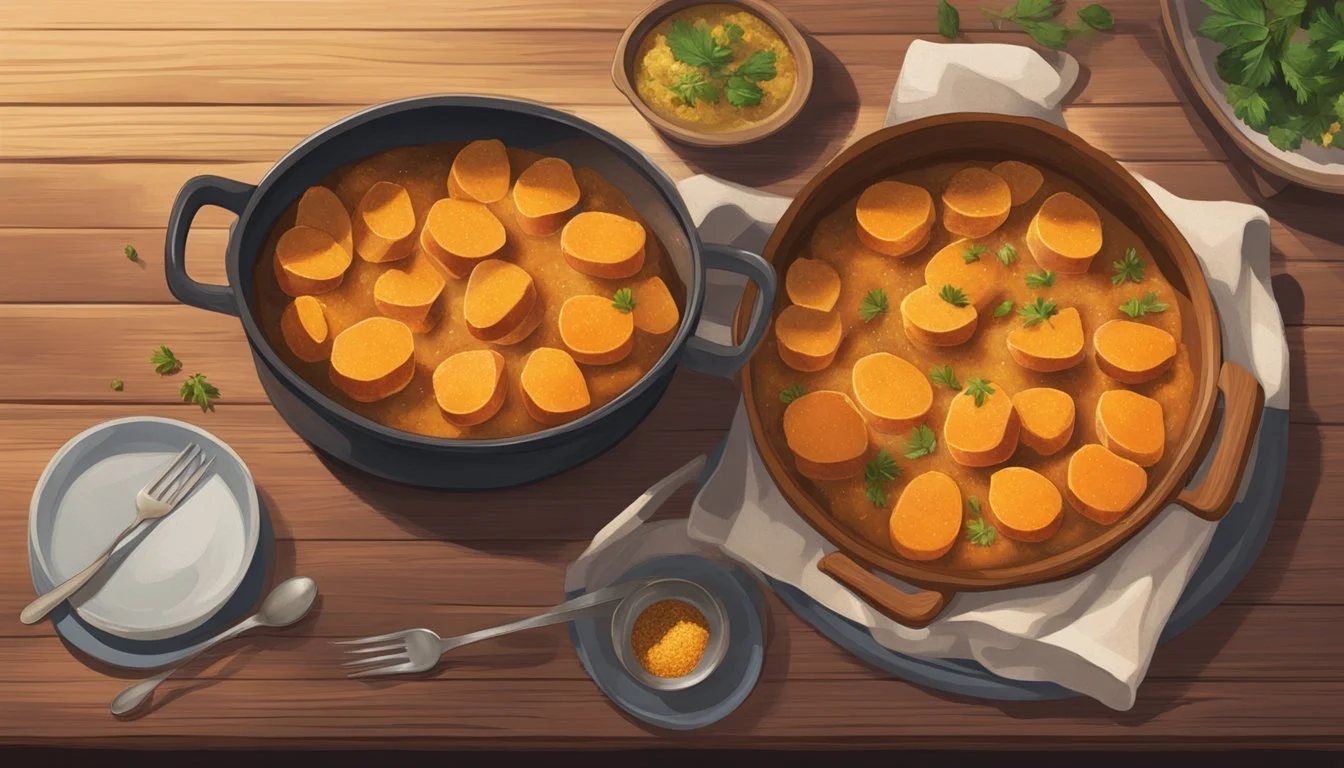How do you eat a yam casserole?
Serving Tips for Enjoying This Hearty Dish
Eating a yam casserole can be a delightful culinary experience, offering both sweet and savory flavors that are deeply satisfying. Typically prepared by combining yams with a blend of seasonings and other ingredients before being baked, this dish is known for its versatility and comfort food appeal. The casserole is usually served warm and can be a standout dish at gatherings, especially during festive seasons when it's often paired with a variety of meats or as a standalone vegetarian option.
The texture and taste of yam casserole depend on the recipe used; some may feature a marshmallow or pecan topping, providing a crunchy contrast to the soft, whipped yams beneath.
Alternatively, a savory version may include ingredients like garlic, herbs, and cheese, tipping the flavor towards a more hearty profile. When eating a yam casserole, it's common for individuals to appreciate the blend of flavors and textures that make this dish unique.
Yam casserole should be eaten slowly to fully enjoy the rich tapestry of tastes it offers. It pairs excellently with a variety of main courses, acting as a flavor-enhancing side dish, but can also be savored on its own. For those who enjoy experimenting with flavors or are looking for a comforting and satisfying meal, yam casserole can be a perfect choice.
Ingredients and Preparations
Creating a yam casserole starts with the selection of high-quality yams and the meticulous combination of sweet and savory ingredients to create a harmonious dish. Precise preparation and cooking techniques ensure the perfect texture and depth of flavor.
Selecting Quality Yams
To begin, choose firm and blemish-free yams or sweet potatoes (What wine goes well with sweet potatoes?). Their firmness is an indication of freshness, which will contribute to the overall texture of the casserole.
Essential Ingredients
For a classic yam casserole, gather the following core ingredients:
Yams/Sweet potatoes: The main ingredient providing a sweet, earthy base.
Sugar: Both brown sugar and white sugar enhance the sweetness.
Butter: Adds richness and helps bind the mixture.
Eggs: Contribute to the casserole's structure and smoothness.
Milk: Evaporated milk or heavy cream adds creaminess.
Flour: Acts as a thickener for the topping.
Additional Flavorings: Cinnamon, nutmeg, vanilla extract, and salt elevate the dish.
Prepping the Dish
Preheat the oven to 350 degrees F (175 degrees C). Grease a casserole dish to prevent sticking. Have all your ingredients measured and within reach to streamline the process.
Pre-Cooking the Yams
Peel and boil the yams in salted water until they are tender enough to be pierced with a fork. Drain well to prevent a waterlogged casserole.
Mixing Techniques
After boiling, mash the yams while warm to achieve a smoother texture. Gradually incorporate the sugar, butter, and eggs. Whip the mixture until fluffy and homogenously combined.
Baking Preparations
Transfer the yam mixture to the prepared baking dish. In a separate bowl, mix the topping ingredients – typically a combination of flour, brown sugar, and butter – and sprinkle over the mixture. For added texture, fold in nuts like pecans, walnuts or almonds. Bake in the preheated oven until the topping is golden and the casserole is heated through.
Constructing the Casserole
Casserole assembly is straightforward, focusing on creating layers that balance the sweet and savory elements of the dish. Proper construction ensures a desirable texture in every bite.
Layering Elements
The base of the casserole begins with a filling typically made of mashed yams or sweet potatoes, which lends a sweet and creamy foundation to the dish. The filling should be well-blended to achieve a smooth consistency. For a more savory dimension, one can incorporate seasonings such as salt or cinnamon, or even a hint of vanilla for extra flavor.
The Baking Process
Once in the casserole dish, the yam casserole is baked in a preheated oven. To ensure even cooking, it should bake at 350 degrees F for about 30 minutes. The baking process is crucial as it allows the dish to develop a golden brown crust on top, which provides both a visual appeal and a textural contrast to the creamy yam filling.
Final Touches
A crucial layer of topping adds a crunchy or crumbly texture opposing the soft filling beneath. Common ingredients for the topping might include a sprinkle of flour, brown sugar, and butter, combined with pecans or marshmallows for that crunchy bite. The topping should be scattered over the yam layer, creating a consistent coating that will crispen up as it finishes baking. The completed side dish delivers a delightful combination of textures and flavors, making the sweet potato casserole truly stand out.
Serving Suggestions
When enjoying yam casserole, its rich, creamy taste and aroma become the stars of any dining experience. Whether served at a holiday feast or a casual potluck, there are ways to enhance its enjoyment further.
Ideal Accompaniments
Side Dishes: Yam casserole pairs excellently with savory side dishes. To complement its sweetness, consider serving it alongside options like roasted vegetables, sweet potato fries, or a green salad.
Main Courses: It's commonly savored as a side dish with traditional holiday proteins such as roasted turkey, baked ham, or grilled chicken.
Dressings: Label your casserole with seasoning suggestions, like a sprinkle of cinnamon or a dash of nutmeg, for guests to tailor the taste to their preference.
Presentation Tips
Dishes: Serve the casserole in a dish that maintains its temperature well to ensure the casserole remains warm throughout the meal.
Garnishing: Add a visual and texture contrast by garnishing with items such as pecans or a dollop of whipped cream for sweet potato pie enthusiasts.
Serving Utensils: Provide the right serving utensils for easy scooping without compromising the casserole's structure.
Storage and Reheating
When dealing with leftovers of a yam casserole, proper storage is key for maintaining its quality. There are multiple reheating options that can return the casserole to a near-fresh state for enjoyment.
Storing Leftovers
To store leftover yam casserole, one should place it in an airtight container and refrigerate it. Refrigeration can preserve the casserole for 3-5 days. If one needs to store it for a longer period, freezing is a viable option. For freezing, it’s important to:
First, allow the casserole to cool to room temperature to prevent condensation.
Wrap it tightly, preferably with a double layer of aluminum foil or cling film.
Label and date the wrapped casserole before placing it in the freezer.
When frozen properly, yam casserole can last for up to 3 months.
Reheating Options
For oven reheating, one should:
Preheat the oven to 350°F (177°C).
Place the yam casserole in an oven-safe dish if it isn't already in one.
Cover with aluminum foil to prevent drying out.
Heat for 20-30 minutes, or until heated through.
With the microwave oven, the steps are:
Transfer the portion of the casserole to a microwave-safe dish.
Cover the dish loosely with a microwave-safe lid or plastic wrap, allowing a small vent for steam to escape.
Reheat on medium power in 1-minute intervals, stirring between intervals to ensure even warmth.
Each reheating method requires careful monitoring to ensure the yam casserole does not dry out or overcook, which can alter its texture and flavor.
Nutritional Information
Yam casserole is a dish that comes with a diverse nutritional profile, providing essential calories and nutrients that can fit into a healthy diet when consumed in moderation.
Caloric Content
The caloric content of a yam casserole can vary depending on the ingredients and serving size. A typical serving contains approximately:
Calories: 180
Calories from Fat: 31.5
These values can help individuals track their energy intake, especially when balancing meals throughout the day.
Macro and Micronutrients
Yam casserole provides a range of macro and micronutrients essential for the body:
Carbohydrates: Yam, the primary ingredient, is a starchy root vegetable and a good source of complex carbohydrates.
Proteins: While yams have a small amount of protein, additional protein can come from ingredients such as pecans or other nuts.
Fats: This dish contains fats from ingredients like butter. It is important to account for:
Saturated fat: Approximately 3.5g
Trans fat: Minimal, if present
Fiber: High in dietary fiber
Vitamins and Minerals: Yams are rich in vitamins such as vitamin C and minerals including potassium.
It’s always advised to choose ingredients that minimize unhealthy fats and added sugars, promoting better nutrition.
Dietary Adjustments
For those needing to make dietary adjustments, a yam casserole can be adapted:
For lower cholesterol and fat:
Substitute butter with a lower-fat alternative or a plant-based oil.
Choose ingredients low in or free of trans fats and cholesterol.
To reduce sodium:
Opt for unsalted butter and lower-sodium seasonings.
By understanding the nutritional information and making appropriate adjustments, yam casserole can be enjoyed as part of a balanced diet.
Variations and Substitutions
Yam casserole is a versatile dish that allows for multiple variations and substitutions to cater to different taste preferences. Whether one desires a sweeter dish or seeks a savory twist, there are options to modify the ingredients accordingly, affecting the dish’s texture and overall flavor profile.
Sweet Variants
Traditional yam casseroles (What wine goes well with casseroles?) often lean toward the sweeter side, incorporating ingredients like marshmallows or maple syrup. To experiment with sweetness levels and textures, one might consider the following:
Using different types of sugars: Swap white sugar for dark brown sugar for a deeper molasses flavor.
Marshmallow topping: A classic addition, providing a gooey texture and sweet flavor. For a twist, use flavored marshmallows.
Savory Alternatives
For those preferring less sweetness, there are savory alternatives that can transform the yam casserole into a more understated side dish:
Addition of spices: Incorporate spices like allspice or ginger to introduce warmth without overwhelming sweetness.
Bacon: Introduce chopped bacon for a smoky, savory flavor that contrasts with the natural sweetness of yams.
Alternative Ingredients
Substitutions can also help tailor the casserole to dietary needs or simply to use what is readily available in the pantry:
Canned yams vs. fresh sweet potatoes: Canned yams are convenient, but fresh sweet potatoes can also be used for a slightly different texture and taste.
Ube: For a unique variation, substitute yams with ube, a purple yam, offering a vibrant color and distinct flavor.
By considering these variations and substitutions, one can easily adapt a yam casserole recipe to fit their preference, be it sweeter, more savory, or simply a healthier or more convenient option.
Preparing for Special Occasions
Yam casserole, a versatile side dish, is especially popular during holiday feasts and can be easily customized to suit a variety of special occasions.
Thanksgiving Recommendations
For Thanksgiving, a yam casserole takes its place alongside turkey and stuffing as a traditional favorite. Ingredients such as cinnamon, nutmeg, and ginger add the warm, spiced flavors that complement the richness of the meal. Topping options include marshmallows or a crumble made from brown sugar, flour, and pecans, baked until golden and crisp.
Spices: Cinnamon, nutmeg, ginger
Toppings: Marshmallows or pecan crumble
Winter Holiday Offerings
During the winter holidays, a yam casserole can be a heartwarming addition to any feast. Enhancements like orange zest or a splash of bourbon in the casserole introduce a festive twist, and a topping of candied pecans or a marshmallow and brown sugar glaze can add a touch of holiday sparkle.
Flavor Enhancers: Orange zest, bourbon
Festive Toppings: Candied pecans, marshmallow and brown sugar glaze
Potluck Considerations
When bringing a yam casserole to a potluck, it should be easy to serve and able to stand out among a variety of dishes. Portability is key, so a sturdy casserole that can be reheated without losing texture or flavor is ideal. Simple, yet rich flavors are best to appeal to a wide range of tastes, and ingredients like pineapple or cranberries can add a noteworthy flavor without overpowering the dish.
Texture & Flavor: Sturdy, reheatable, rich but simple
Unique Ingredients: Pineapple, cranberries
Tips and Tricks
When mastering the art of yam casserole preparation, it's crucial to consider cooking time adjustments, flavor enhancements, and preparation shortcuts. These facets can have a direct impact on the texture, taste, and overall enjoyment of the dish.
Cooking Time Adjustments
The ideal cooking time for a yam casserole often hinges on factors such as the size and depth of the dish. An average guideline is baking at 350 degrees F (175 degrees C) for 30 minutes. However, if one cuts the yams into smaller pieces, they may cook faster, requiring a decrease in cooking time. Conversely, larger chunks might necessitate a longer time in the oven to ensure they are tender.
Enhancing Flavors
One can elevate the flavors in a yam casserole by incorporating spices like cinnamon, which complements the natural sweetness of the yams. To achieve a richer taste, adding butter will contribute both flavor and a creamy texture. For an extra dimension of sweetness and comfort, a teaspoon of vanilla extract can be mixed into the yam blend before baking.
Preparation Shortcuts
For those seeking to minimize prep time, one can use the microwave to soften the yams before baking, slashing the overall cooking duration. Here, the yams are pricked with a fork and microwaved until partially cooked, typically for about 5-10 minutes. This method makes it easy to mash the yams and mix with other ingredients, expediting the baking process without sacrificing the dish's quality.
Conclusion
A yam casserole presents a blend of sweet and savory flavors, making it an exceptional dish for gatherings, particularly during Thanksgiving. The creamy texture coupled with a crumbly, nutty topping satisfies a variety of taste preferences and often leaves guests seeking seconds. Preparing this dish incorporates simple steps: mashing the cooked yams until smooth, mixing with spices and sweeteners, and then topping with a mixture that may include flour, brown sugar, butter, and chopped pecans.
Nutritional Aspects
Yams are a rich source of vitamins, like vitamin C and B-complex, and are full of fiber and potassium. Incorporating yams into a casserole adds nutritional benefits, though one should consider the added sugars and fats in the recipe when assessing its overall health profile.
Preparation Tips
For a velvety casserole, ensure yams are well-cooked before mashing. Add spices such as cinnamon, nutmeg, or cloves for a warm, comforting aroma, and consider a variety of toppings to add texture.
Serving Suggestions
When serving this casserole, they should allow it to rest before scooping, this ensures it holds its shape and enhances the flavor development. Portion the casserole into neat servings and provide additional toppings on the side for those who enjoy personalizing their dish.
In conclusion, a yam casserole is a thoughtful addition to any festive meal, offering not only taste and nutrition but also a comforting appeal. It has gained its rightful place on the Thanksgiving table and is sure to impress all who partake.










